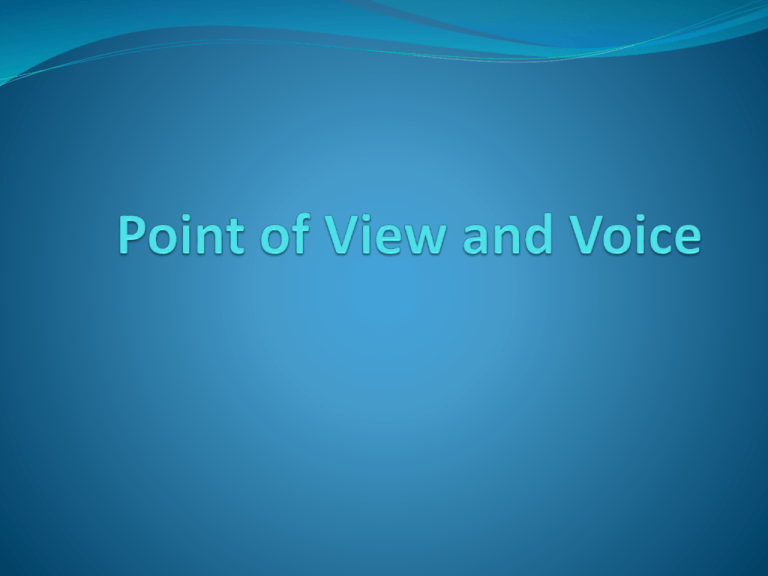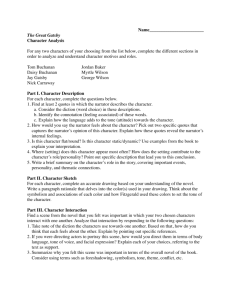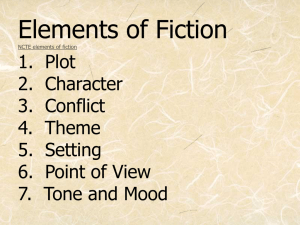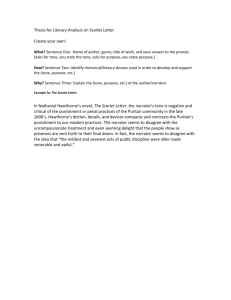Point of View and Voice pp
advertisement

Point of view The vantage point or perspective of the narrator. How might changing the point of view change the reader’s perception of the story? Omniscient P.O.V. The observer is not a character in the story Is godlike or all knowing Can see into every character’s heart and mind Uses the pronouns “he,” “she,” and “they” Omniscient P.O.V Example The frown on the bachelor’s face was deepening to a scowl. He was a hard, unsympathetic man, the aunt decided in her mind. . . . The smaller girl created a diversion by beginning to recite “On the Road to Mandalay.” She only knew the first line, but she put her limited knowledge to the fullest possible use. . . . It seemed to the bachelor as though someone had had a bet with her that she could repeat the line aloud two thousand times without stopping. from “The Storyteller” by Saki First Person P.O.V Story is told by a character within the story (usually the protagonist) Uses the pronouns “I” and “we” Literary critics often use the term persona to refer to this first person narrator What are the benefits of using a first person narrator? Why might an author choose NOT to use a first person narrator? Unreliable Narrator A narrator is not reliable when he or she misleads or misinforms readers How so? He or she could be … A) mentally ill (insane) Examples? B) telling only part of the truth, lying, or exaggerating Why do this? C) lacking insight or knowledge about a situation D) piecing together a memory E) a child or immature narrator Examples? Do we always know an author is unreliable? Why might an author include an unreliable narrator? What effects result from having an unreliable narrator? Bias • A person has a bias when he or she favors some things (people, activities, events, qualities, etc.) over others. • A person’s individual biases are shaped by his or her personal experiences. • WE ALL HAVE BIASES. • Every person will perceive an event differently because of his or her biases. Third Person Limited P.O.V. The observer is NOT a character in the story. Focuses on the perspective of one character Plot events are limited to what this one character experiences or observes. Does not know what all characters are thinking or feeling Uses the pronouns “he,” “she,” and “they” Third person limited p.o.v. “Hot in here,” he muttered to himself. Then, from the short hallway at his back, he heard the muffled clang of wire coat hangers in the closet, and at this reminder of what his wife was doing he thought: hot – guilty conscience. From “Contents of the Dead Man’s Pocket” by Jack Finney Determining P.O.V Who is telling the story? How much does the narrator know and understand? Can I trust the narrator? In what ways would the story be different if someone else were telling it? How much does this narrator want me to know? Objective vs. subjective view Objective view – not influenced by personal feelings; factual Subjective view – influenced by personal feelings An omniscient narrator reveals an objective view A first person narrator reveals a subjective view Choosing P.O.V. Limited ------------------------------------Complete understanding understanding Subjective --------------------------------- Objective view view First Person Third Person limited Omniscient Voice A character or author’s distinctive use of language A) Choice of words (diction) B) Attitude (tone) Diction Choice of words and phrases Connotation is the feeling of a word (generally agreed upon within a culture) Positive connotation: proud, self-confident, secure Negative connotation: self-involved, cocky, egotistical, full of himself Neutral connotation: desk, pencil, telephone, etc. Diction More examples: Strong-willed Independent Stubborn Bossy Tone The attitude a speaker OR writer takes toward a subject, character, or reader. May be sympathetic, critical, humorous, tragic, hopeful, bitter, etc. A madman’s tone would be different from a saintly mother’s tone Tone is most greatly influence by diction (choice of words) Mood vs. Tone The mood and tone of a story may be the same, or they may be different. How so? Remember: Mood is the atmosphere of the story (influenced by elements of setting) Mood is how the reader feels Tone is how the speaker or writer feels Tone examples See notes.







